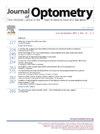Evaluation of binocular summation ratio before and after vision training in patients with intermittent exotropia: A pilot prospective cohort study
IF 1.8
Q2 OPHTHALMOLOGY
引用次数: 0
Abstract
Purpose
To investigate the binocular summation ratio (BSR) in intermittent exotropia (IXT) before and after vision training under varying light conditions, and to evaluate its association with the control of deviation.
Methods
Twenty IXT patients were included in the study. Patients were divided into three groups based on their control of deviation: poor, fair, and good control. Contrast sensitivity was assessed using the CSV1000-HGT chart at four spatial frequencies, evaluated both monocularly and binocularly from a distance of 2.5 meters. This evaluation occurred under both photopic and mesopic lighting conditions, with and without glare. Additionally, the BSR for each patient was calculated before and after the vision training process.
Results
The mesopic BSR under glare-free conditions demonstrated a significant increase following vision training. In the presence of glare, the mesopic BSR significantly increased across all spatial frequencies: 3, 6, 12, and 18 cycles/degree. Additionally, after vision training, the photopic BSR in glare-free conditions also showed an increase at all frequencies. However, under glare conditions, the photopic BSR only increased at the frequencies of 3, 12, and 18 cycles/degree, but this increase was not statistically significant. A significant increase in the BSR was observed only at the frequency of 6 cycles/degree. Furthermore, following vision training, the degree of control over deviation improved significantly.
Conclusion
The BSR and deviation control scores in patients diagnosed with IXT demonstrated significant improvement following vision training, underscoring the efficacy of this treatment method in the management of IXT.
间歇性外斜视患者视力训练前后的双眼综合比率评估:一项前瞻性队列研究
目的探讨不同光照条件下间歇性外斜视(IXT)患者视力训练前后的双眼总合比(BSR),并评价其与偏差控制的关系。方法选取20例IXT患者作为研究对象。根据偏差控制情况将患者分为控制差、控制一般、控制良好三组。使用CSV1000-HGT图表在四个空间频率下评估对比灵敏度,在2.5米的距离上进行单眼和双目评估。这种评价发生在光和介观照明条件下,有眩光和没有眩光。此外,在视力训练过程前后计算每位患者的BSR。结果无眩光条件下的中观BSR在视力训练后有明显提高。在强光下,介观BSR在3、6、12和18周期/度的空间频率上均显著增加。此外,经过视觉训练后,无眩光条件下的光性BSR在所有频率下也显示出增加。然而,在强光条件下,光性BSR仅在3、12和18 cycles/度频率下增加,但这种增加没有统计学意义。仅在6个周期/度的频率下观察到BSR的显著增加。此外,经过视觉训练后,对偏差的控制程度显著提高。结论经视力训练后,诊断为IXT患者的BSR和偏差控制评分均有显著改善,说明该治疗方法对IXT的治疗效果显著。
本文章由计算机程序翻译,如有差异,请以英文原文为准。
求助全文
约1分钟内获得全文
求助全文

 求助内容:
求助内容: 应助结果提醒方式:
应助结果提醒方式:


